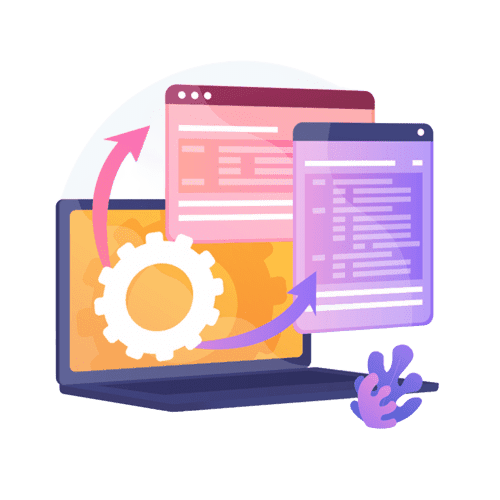[dsm_gradient_text gradient_text="Your AI Ready for the Future? Inside the New AI Maturity Model" _builder_version="4.27.0" _module_preset="default" header_font="Questrial|||on|||||" header_text_align="center" header_letter_spacing="5px" filter_hue_rotate="100deg"...
CMMI Level 2 SAM Process Area: A Comprehensive Overview
Discover the critical role of Supplier Agreement Management (SAM) in CMMI Level 2 for effective software acquisition and quality assurance. Learn how integrating non-technical features catalogues can streamline supplier evaluation, minimize risks, and optimize project outcomes.

In today’s rapidly evolving software development landscape, quality assurance and process improvement are more critical than ever. Organizations are increasingly adopting frameworks like Capability Maturity Model Integration (CMMI) to enhance their software processes, ensure better quality, and manage risks effectively. Among the various process areas (PAs) defined in CMMI Level 2, Supplier Agreement Management (SAM) plays a pivotal role in overseeing relationships with suppliers, especially when dealing with Commercial-Off-The-Shelf (COTS) products or outsourced software components.
This post delves into the SAM process area within CMMI Level 2, emphasizing its significance, challenges, and best practices. We will explore the integration of non-technical features catalogues to streamline supplier management, as discussed in the study by Carvallo et al., and analyze a real-world case study involving ETAPATELECOM, a telecommunications company in Ecuador.
Understanding CMMI Level 2 and Supplier Agreement Management
CMMI Overview
CMMI (Capability Maturity Model Integration) is a process-level improvement training and appraisal program administered by the CMMI Institute. CMMI is structured into five maturity levels, each of which groups a set of predefined process areas that are critical for software engineering and development practices. These levels range from Level 1 (Initial) to Level 5 (Optimizing), indicating the organization’s maturity in handling software projects effectively.
CMMI Level 2, known as the “Managed” level, focuses on establishing basic project management practices. Organizations at this level are characterized by their ability to repeat successful processes across similar projects, ensuring that successful practices are retained even in stressful situations.
Supplier Agreement Management (SAM) in CMMI Level 2
SAM is a key process area in CMMI Level 2, specifically designed to manage the acquisition of products and services from suppliers. This area addresses the complete lifecycle of supplier management, from selecting suppliers, establishing agreements, to overseeing the execution and ensuring compliance with the terms of the agreement. The primary goals of SAM include:
Establishing Supplier Agreements: Ensuring that all supplier-related agreements are well-documented, comprehensive, and in alignment with the organization’s requirements and project objectives.
Satisfying Supplier Agreements: Monitoring and managing supplier performance to ensure that all contractual obligations are met, and the acquired products or services meet the expected quality and functionality.
The SAM process area is crucial when dealing with COTS products or outsourced software components, as it mitigates risks associated with supplier reliability, product quality, and compliance.

Increased Adoption
As of 2022, over 10,000 organizations worldwide have adopted CMMI models, highlighting its role as a leading framework for process improvement and capability development across various industries.
%
Quality Improvement
Organizations that implement CMMI Level 2 processes, including SAM, report a 30% reduction in defects and rework costs, demonstrating the effectiveness of standardized supplier management and
Non-Technical Features in SAM: Enhancing Supplier Management
The Role of Non-Technical Features
While the technical quality of software products is often emphasized, non-technical features play a significant role in the success of supplier management. Non-technical features include aspects such as cost, licensing, support services, supplier reputation, and risk management, which are not directly related to the software’s intrinsic quality but significantly impact the overall project outcome.
The study by Carvallo et al. highlights the importance of integrating non-technical features catalogues to support CMMI Level 2 SAM practices. These catalogues provide a structured approach to defining, categorizing, and evaluating non-technical aspects, ensuring a comprehensive analysis during supplier selection and management.


Developing Non-Technical Features Catalogues
Carvallo et al. proposed a method for constructing a non-technical features catalogue tailored to CMMI Level 2 SAM requirements. The development process involves the following steps:
Defining Characteristics and Subcharacteristics: The catalogue starts by identifying high-level non-technical characteristics (e.g., supplier reputation, cost management) and breaks them down into more specific subcharacteristics.
Customizing the Catalogue: Organizations can customize the catalogue based on their specific needs, project context, and industry standards. This customization ensures relevance and applicability to the particular software acquisition scenario.
Using Metrics for Evaluation: Each non-technical feature is associated with specific metrics that facilitate quantitative evaluation. These metrics provide a uniform way of comparing different suppliers and products, aiding decision-making.
Case Study: Implementing SAM in ETAPATELECOM
Background of ETAPATELECOM
ETAPATELECOM is a telecommunications company based in Cuenca, Ecuador, providing internet access, data carrying, and fixed telephone services. To support its growth and operational needs, ETAPATELECOM initiated a project to select and adopt several COTS components required for its operations, including mediation, billing, ERP, CRM, BSC, and Call Center management components.
Application of Non-Technical Features in SAM
The implementation of SAM in ETAPATELECOM involved using a non-technical features catalogue to streamline the supplier selection and agreement processes. Key steps included:
- Determining Acquisition Type: The organization evaluated the feasibility of acquiring components from external suppliers versus in-house development. Non-technical features such as cost, support availability, and supplier reputation played a critical role in this decision-making process.
- Selecting Suppliers: ETAPATELECOM issued Request for Information (RFI) forms structured around the non-technical features catalogue. Suppliers were evaluated based on their responses, focusing on non-technical aspects like organizational structure, licensing options, and service guarantees.
- Establishing Supplier Agreements: Detailed agreements were established, incorporating non-technical attributes to ensure clarity and minimize risks. These agreements covered aspects such as budget, timelines, support services, and warranties.
- Monitoring and Executing Agreements: The non-technical features catalogue provided a framework for ongoing monitoring of supplier performance, ensuring adherence to contractual terms and facilitating early detection of potential issues.
- Acceptance and Transition: The final work products were assessed not only for technical compliance but also for adherence to non-technical commitments. This approach ensured a smooth transition of products into operational use, with clear guidelines for future support and maintenance.
Best Practices for Effective SAM Implementation
Based on the insights from the ETAPATELECOM case study and broader industry experience, the following best practices can enhance SAM implementation in CMMI Level 2 organizations:
- Develop Comprehensive Non-Technical Features Catalogues: Organizations should invest in developing detailed catalogues that cover all relevant non-technical aspects. These catalogues should be tailored to the specific industry and project requirements.
- Integrate Non-Technical Evaluation into Supplier Selection: Non-technical features should be a key component of the supplier evaluation process, alongside technical quality. This integration ensures a holistic view of supplier capabilities and potential risks.
- Use Structured RFIs for Information Gathering: Issuing structured RFIs based on the non-technical features catalogue helps standardize supplier responses, making comparison and evaluation more straightforward.
- Monitor Supplier Performance Against Non-Technical Commitments: Regular monitoring and assessment of supplier performance against non-technical criteria help maintain project alignment and address issues proactively.
- Engage in Continuous Improvement: Organizations should periodically review and update their non-technical features catalogues and SAM practices based on feedback and evolving industry standards.
Conclusion
The Supplier Agreement Management process area is integral to achieving CMMI Level 2 maturity, particularly for organizations relying on COTS products and outsourced software components. By incorporating non-technical features catalogues, organizations can enhance their SAM practices, ensuring comprehensive evaluation, effective supplier management, and successful project outcomes. The case of ETAPATELECOM illustrates the practical application of these principles, demonstrating how a structured approach to non-technical features can lead to better decision-making, reduced risks, and improved supplier relationships. As organizations continue to navigate the complexities of software acquisition, the adoption of such best practices will be essential for sustained growth and success.
References
- Carvallo, J. P., Franch, X., & Quer, C. (2008). Supporting CMMI Level 2 SAM PA with Non-technical Features Catalogues. Software Process Improvement and Practice, 13(2), 171-182.
- Chrissis, M. B., Konrad, M., & Shrum, S. (2003). CMMI: Guidelines for Process Integration and Product Improvement. Addison-Wesley.
- International Organization for Standardization (ISO). (2001). ISO/IEC 9126-1: Software Engineering – Product Quality, Part 1.
- Royce, W. (2002). CMM vs. CMMI: From Conventional to Modern Software Management. The Rational Edge.
Wanna know more? Let's dive in!
Cooling the Future: How AI Makes Data Centers Greener
[dsm_gradient_text gradient_text="Cooling the Future: How AI Makes Data Centers Greener" _builder_version="4.27.0" _module_preset="default" header_font="Questrial|||on|||||" header_text_align="center" header_letter_spacing="5px" filter_hue_rotate="100deg"...
When Cars Became Code: How AI is Redefining Automotive Production
[dsm_gradient_text gradient_text="When Cars Became Code: How AI is Redefining Automotive Production" _builder_version="4.27.0" _module_preset="default" header_font="Questrial|||on|||||" header_text_align="center" header_letter_spacing="5px" filter_hue_rotate="100deg"...
Supercharged Smarts: How AI Is Rewiring Electric Vehicle Batteries
[dsm_gradient_text gradient_text="Supercharged Smarts: How AI Is Rewiring Electric Vehicle Batteries" _builder_version="4.27.0" _module_preset="default" header_font="Questrial|||on|||||" header_text_align="center" header_letter_spacing="5px" filter_hue_rotate="100deg"...
New Zealand 2025
Duration: 2 weeks Cities: Christchurch, Hokitika, Kaikōura, Westport, Te Waipounamu, Nelson, Timaru Miles Travelled: 30 000Traveling through parts of New Zealand’s South Island offers a rich tapestry of history, landscape, and local character that leaves a quiet...
Resolving Die Peel Issues in an Automotive & Aerospace Electronics Manufacturing Plant
Background A global electronics manufacturer supplying critical components to the automotive and aerospace industries received multiple customer complaints regarding the premature failure of transistor-based power modules. Field analysis revealed that the root cause...
Transforming a Dysfunctional Quality Team in Automotive and Aerospace Manufacturing
Background The quality department of a Tier-1 manufacturer in the automotive and aerospace sectors was expected to ensure strict compliance to both customer and regulatory standards. Instead, it became a bottleneck plagued by poor collaboration, low morale, and high...
Resolving Customer Complaints Related to Electrical Connector Module Failures
Background ElectroTech, a manufacturer of electrical distribution components, including connector modules for power systems, received a major customer complaint regarding intermittent connection failures in one of its core electric product lines. The failures led to...
Singapore 2019
Duration: 3 days Cities: Singapore Miles Travelled: 6,300Visiting Singapore was like stepping into the future while still being surrounded by rich history and culture. From the moment I arrived at Changi Airport, with its indoor waterfalls and lush gardens, I knew...
Hawaii 2015
Duration: 2 weeks Cities: Honolulu Miles Travelled: 7,000Our trip to Hawaii was truly a once-in-a-lifetime experience, filled with breathtaking landscapes, warm hospitality, and unforgettable moments. We stayed in Honolulu on the island of Oahu, where the vibrant mix...
North East England 2024
Duration: 2 weeks Cities: Durham, Beamish Miles Travelled: 200Traveling to North East England offers a unique blend of history, culture, and character that stays with you long after you leave. One of the highlights is the enchanting city of Durham. Its cobbled streets...
Japan 2019
Duration: 2 weeks Cities: Osaka, Tokyo, Hiroshima, Kyoto Miles Travelled: 9,000Japan in spring is pure magic. Spring felt like a moment suspended in time. The cherry blossoms were at their peak, casting a soft pink glow over temple roofs and narrow cobblestone lanes....












